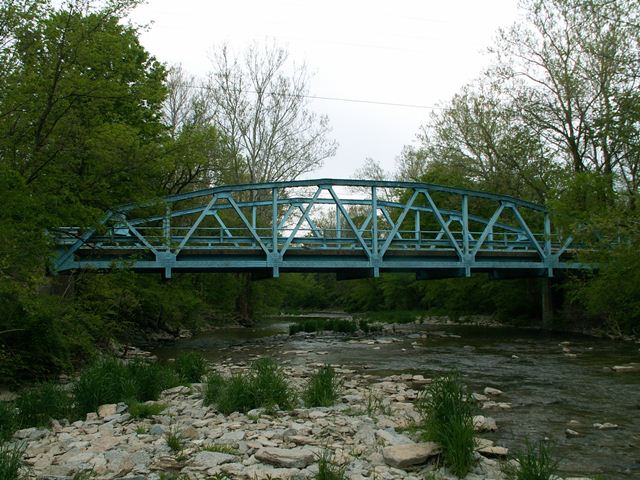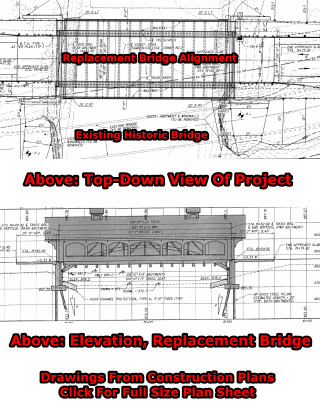We Recommend:
Bach Steel - Experts at historic truss bridge restoration.
Camden College Corner Road Bridge
Hueston Woods Bridge

Primary Photographer(s): Nathan Holth
Bridge Documented: May 7, 2006
Rural: Preble County, Ohio: United States
1929 By Builder/Contractor: Brookville Bridge Company of Brookville, Ohio
Not Available or Not Applicable
103.0 Feet (31.4 Meters)
111.0 Feet (33.8 Meters)
20 Feet (6.1 Meters)
1 Main Span(s)
6841481

View Information About HSR Ratings
Bridge Documentation
This bridge no longer exists!
View Archived National Bridge Inventory Report - Has Additional Details and Evaluation
This Historic Bridge Was Demolished By Preble County October 11, 2011 And Replaced With A Fake Non Historic Wooden Covered Bridge
A Disgraceful And Unfair Bridge Project
First-time visitors to HistoricBridges.org might find it odd that a website dedicated to "promoting the preservation of our transportation heritage" would purposely exclude wooden covered bridges from inclusion on the website. However there is perhaps no better explanation for why this exclusion is made than reviewing what Preble County is doing with the Camden College Corner Road Bridge.
The United States has idolized and obsessed over wooden to the point where these bridges are so overrated that many wooden covered bridges have done irreversible harm to the nation's population of non-covered historic bridges. Federal funding programs have targeted the preservation of covered bridges and covered bridges only, leaving metal truss bridges and concrete arch bridges to deteriorate and be demolished and replaced destroying that heritage forever. Covered bridges and covered bridges only have been promoted in literature, film, travel brochures, and advertisements to the point where the general public is highly aware of covered bridges but has little if any awareness of the equally significant value of historic metal, concrete, and stone bridges. An enormous imbalance is present in the United States when comparing the number of preserved covered bridges to preserved historic bridges of other types. Worse, many covered bridges described as "historic" have very little actual historic value. Many of these bridges suffer from a nearly complete loss of original materials, and others have been retrofitted with superstructures that render the covered bridge little more than a non-functional decoration. In other cases, modern covered bridges are constructed and presented to the public as historic bridges, which they are not. In contrast, many historic bridges such as metal truss bridges and concrete arch bridges display an extremely high degree of original materials and original design, yet are being demolished and replaced.
Of all the disgraceful ways it might be possible to demonstrate a gross and unfair favoritism toward covered bridges perhaps none is greater than the Camden College Corner Road Bridge. The bridge is a beautiful riveted polygonal Warren pony truss with excellent historic integrity. Structurally, the bridge is in decent condition although the flooring system including deck stringers and floor beams might need to be replaced as part of a comprehensive rehabilitation to bring the bridge back to like-new condition. The trusses themselves still have a fairly good paint system present, and likely would only need minor repairs and a new coat of paint to restore them. Not only would rehabilitation likely cost less than replacement and save taxpayers money, it would also preserve a beautiful historic bridge.
What, then, is Preble County's solution? Build a fake modern wooden covered bridge that has no heritage value whatsoever and only serves to create a false sense of history. This bridge is to be built on a new alignment, next to the historic truss bridge. Then, the historic metal truss bridge is to be demolished, even though the plans show that it is not in the way of its replacement. If this project were to proceed as planned, except that it would leave the historic truss bridge standing next to its replacement, this would not be a serious issue. Certainly, the covered bridge would create a false sense of history, but as long as the genuine historic bridge remained in place this would be a very minor issue. However to demolish the historic bridge when it isn't in the way of the replacement bridge is nothing less than a waste of taxpayer dollars. Closed to vehicular traffic, this historic bridge would likely stand next to its replacement as-is for decades with no issues. The generous posted weight limit of 26 tons for the historic bridge demonstrates that the bridge is not on the verge of collapse under its own weight.
Demolishing a historic metal truss bridge and building a replacement non-historic modern covered bridge and is one of the most ridiculous projects to be encountered in the United States. The project sends a false message. To the general public, it tricks people into thinking Preble County cares about historic bridges and that they care about the beauty of their roads. The reality is that Preble County has chosen to demolish a riveted metal truss bridge with heritage value and they have replaced it with a bridge with no historic value whatsoever. Preble County in reality is wasting tax dollars and demonstrating a complete lack of concern for historic bridges.
Given that Preble County has a number of historic metal truss bridges, some of them nationally significant, this project raises serious concerns about the future of the other historic bridges in the county. Does the county plan to annihilate all of its historic metal truss bridges and replace them with fake modern covered bridges? It is hoped that the county will realize the error of its decision with this bridge and instead choose to rehabilitate its remaining historic metal truss bridges. Should the county choose rehabilitation, HistoricBridges.org would be happy to support such an effort and would gladly assist the county in locating engineers and contractors who can produce the best quality work for the least amount of money.
Discussion of Bridge
Except for a lack of v-lacing and a different builder, this bridge has a striking resemblance to the Indian Trail Road Bridge back in Michigan, although the two bridges are completely unrelated in any way except for the period in which they were built. Particularly the railing design on the bridge, which includes a pole and a strip of riveted steel below, is very similar to Indian Trail.
This bridge is a warren pony truss with a polygonal top chord. It features riveted connections. V-lacing is present under the top chord. The members of this bridge are simple i-beams in design. The single span structure rests on concrete abutments. There are rocker bearings at the east end of the truss. The bridge was built in 1929. The deck is concrete with an asphalt wearing surface. The floorbeams under the bridge appear to have been replaced, as indicated by welding around the bottom chord connections. Regardless, these floorbeams today are quite badly rusted. Perhaps it is a testament to the lesser quality of modern steel compared to the pure steel used back during the truss bridge era. See the photos gallery, just below the full/wallpaper sized images for photos of the weld marks and rusty beams.
Be sure to visit the page for the Foos Road Bridge, another similar bridge in the county built by the same company, the Brookville Bridge Company of Brookville, OH.
Information and Findings From Ohio's Historic Bridge InventorySetting/Context The bridge carries a 2 lane road over a stream in a sparsely developed, rural setting. Physical Description The 1-span, 111'-long and 20.6'-wide, rivet-connected Warren pony truss bridge has a polygonal upper chord and verticals. The chords are built-up members and the verticals and diagonals are rolled sections. The lower chord connections have been altered by replacement of rivets with bolts for the floorbeam connections. The floorbeams originally were level with or slightly above the lower chords (see old survey photos) but are now carried below the lower chords with a welded connection plate. The bridge has rolled stringers and a concrete deck. The bridge has steel channel guard rails with a pipe hand rail. The concrete abutments have been repaired with concrete including extensive work for new bearing areas for the truss's rocker bearings. Integrity Replaced floorbeams and altered lower-panel connections with combination of bolts and welded connections (ca. 1985). Alterations to concrete abutments. Summary of Significance The 1929 Warren pony truss is a later example of its type/design with no distinguishing features. The integrity of original design has been impacted by alterations to the lower-chord panel points and connections
to accommodate replacement floorbeams. The truss has riveted connections, typical of Warren trusses from about 1900 to the 1940s when riveted connections began to be phased out in favor of welded connections. This example is not
historically significant for its technology or context. More complete and distinguished examples better represent the significance of the type/design to the development of the state's road systems. The not eligible recommendation of
the prior inventory remains appropriate. Bridge Considered Historic By Survey: No |
![]()
Photo Galleries and Videos: Camden College Corner Road Bridge
Bridge Photo-Documentation
Original / Full Size PhotosA collection of overview and detail photos. This gallery offers photos in the highest available resolution and file size in a touch-friendly popup viewer.
Alternatively, Browse Without Using Viewer
![]()
Bridge Photo-Documentation
Mobile Optimized PhotosA collection of overview and detail photos. This gallery features data-friendly, fast-loading photos in a touch-friendly popup viewer.
Alternatively, Browse Without Using Viewer
![]()
Maps and Links: Camden College Corner Road Bridge
This historic bridge has been demolished. This map is shown for reference purposes only.
Coordinates (Latitude, Longitude):
Search For Additional Bridge Listings:
Bridgehunter.com: View listed bridges within 0.5 miles (0.8 kilometers) of this bridge.
Bridgehunter.com: View listed bridges within 10 miles (16 kilometers) of this bridge.
Additional Maps:
Google Streetview (If Available)
GeoHack (Additional Links and Coordinates)
Apple Maps (Via DuckDuckGo Search)
Apple Maps (Apple devices only)
Android: Open Location In Your Map or GPS App
Flickr Gallery (Find Nearby Photos)
Wikimedia Commons (Find Nearby Photos)
Directions Via Sygic For Android
Directions Via Sygic For iOS and Android Dolphin Browser
USGS National Map (United States Only)
Historical USGS Topo Maps (United States Only)
Historic Aerials (United States Only)
CalTopo Maps (United States Only)


